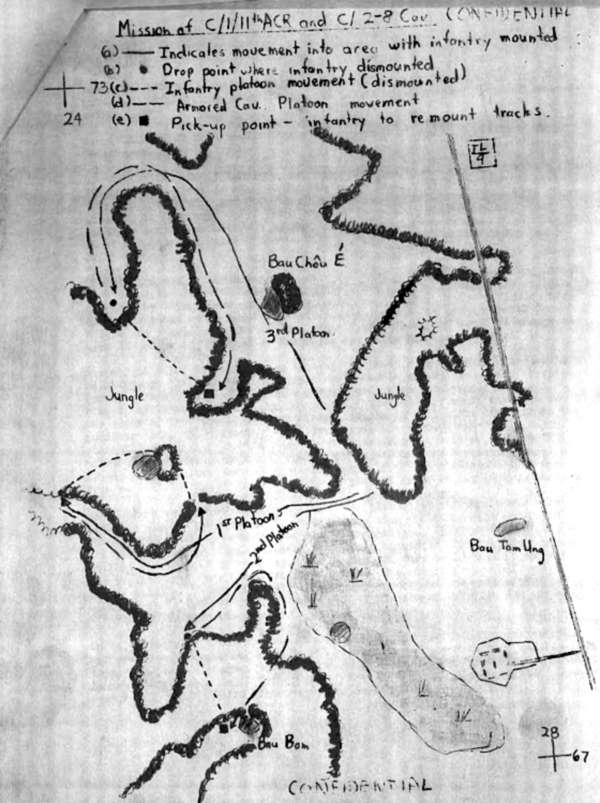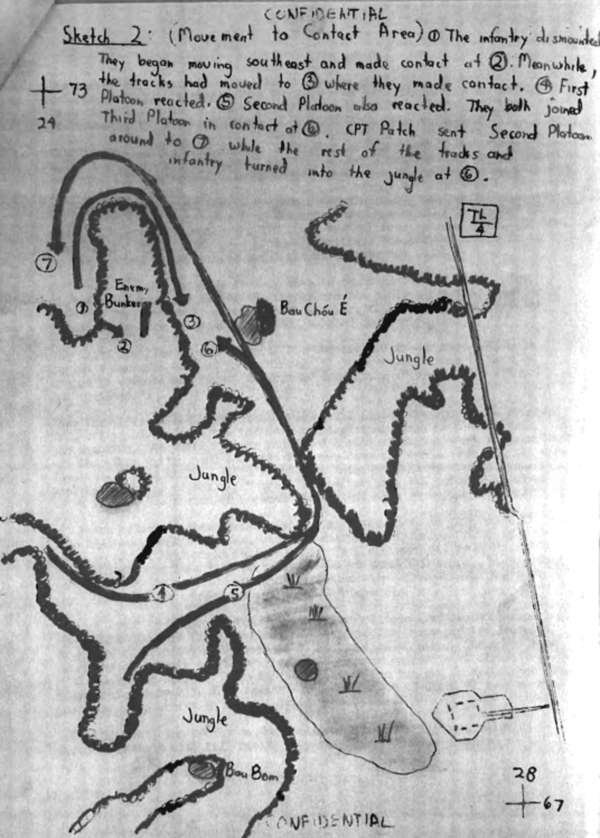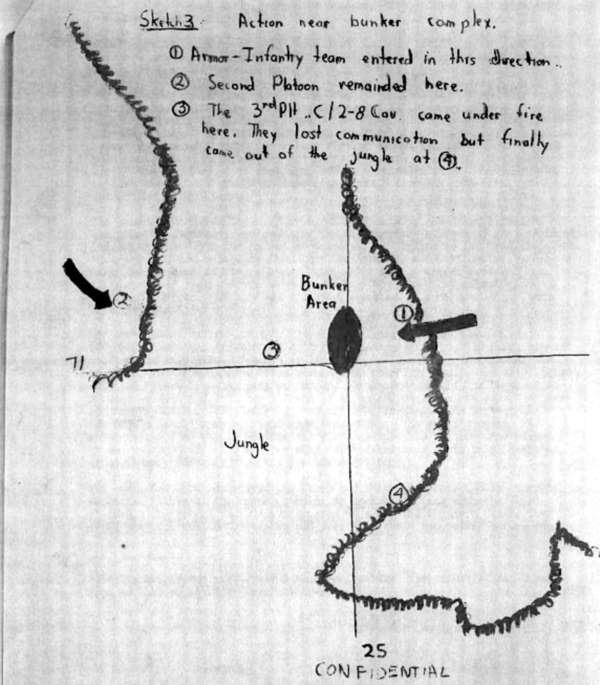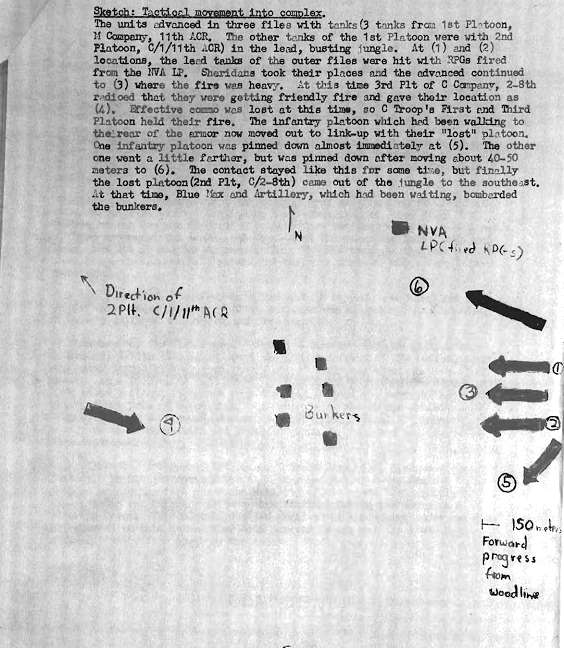| |
|



|
The short entry in a Daily Staff Journal shows the following entry: C Company/2-8 Cav, C Troop/1-11 ACR, and M Company/3-11 ACR near grid XT 251704 at 1445 hours, while on a ground recon, received small arms and automatic weapons fire and rocket propelled grenades (RPG) from an unknown sized enemy force, with rounds coming from the North and West. The units engaged the enemy with organic weapons, artillery, Aerial Rocket Artillery (ARA) and the contact was broken by 1515 hours. At this time, there were no friendly casualties but a sweep of the area found two NVA killed in action (KIA). At 1555 hours, while continuing the sweep, the unit received 10 rounds of 60mm mortars from the west, with rounds impacting in and around their immediate area. Twenty minutes later, they began to receive small arms and automatic weapons fire and rocket propelled grenades (RPG) from a still unknown sized enemy force. Rounds were coming in from the West and Northwest this time. Again the enemy was engaged with artillery, and ARA but the contact continued sporadically until 1840 hours. The results were 31 NVA KIA; C/2-8 had 6 KIA, 21 Wounded in action (WIA) and 2 Missing in Action (MIA); 11th ACR had 2 KIA and 9 WIA. The 11th ACR had also lost an M-113A1 Armored Cav Vehicle and M-48A tank, damage unknown. A further sweep of the area on 15 February was conducted and at 1800 hours, they recovered the 2 MIAs who were KIA as well as the damaged ACAV and tank, which was stripped. They also found another NVA KIA. In another part of this area on the 15th, at 1215 hours, B Company, 2-8th Cavalry engaged an unknown number of enemy soldiers. Small arms fire was exhanged and the enemy used RPG fire. The troopers were supported by helicopter gunships, artillery, and tactical aircraft. Within 5 minutes, the enemy withdrew leaving 3 of their dead, but US casualties during this brief encounter were two KIA and five WIA. Records show on 14 and 15 February 1970, thirteen US soldiers died in an engagement in the vicinity of 4 kilometers Northwest of Bau Tam Ung, 13 Km North-Northwest of Nui Ba Den Mountain, in Tay Ninh Province. They were:
The detailed report for the all afternoon encounter by C/2-8 Cavalry and 11th ACR elements shows a more complex story of the intense fight. The operation was a combined infantry and armor reconnaissence of suspected enemy positions. There were no supporting forces used during the initial and main contact, but afterward, light fire teams, artillery, Aerial Rocket Artillery (ARA) and USAF air strikes were used. During the entire month of February, A and C Troops, 1st Squadron, 11th ACR, and a platoon of tanks from M Company, 3rd Squadron, 11th ACR had been under the operational control of the 2nd Battalion, 8th Cavalry, 1st Cavalry Division. The task force, known as TF-2-8, had conducted extensive reconnaissance and Rome Plow operations in War Zone C to interdict infiltrating enemy forces and to disrupt the enemy lines of communication. On 13 February, inteligence reports indicated that grid coordinates XT248706, XT237698, and XT251679 were possible enemy troop concentrations. The 2-8th command assigned the task force the mission of reconning these areas on the 14th of February, 1970 - St Valentine's Day. Neither Captain of the armor unit or infantry unit, were given command of the Task Force. They operated under an unusual command structure - they were to command jointly under the overall command of the 2-8th Cav. The mission was difficult, even for a combined force. Each suspected location was in extremely dense jungle. These areas could be reconned by using armor exclusively, only infantry, or both. If armor were to be used, the tanks would have to "bust" jungle, because it was too thick for ACAVs and Sheridans. The noise of the 'jungle busting' would be enough to warn any enemy in the area of the plans and allow them to react. Instead of using armor alone, the two commanders decided to have the infantry platoons walk through the areas. The armor would remain as a ready reaction force. This was possible because each suspect area was ringed, at least partially, by open areas. The infantry would dismount on the edges of the jungle, conduct recon in a straight line across the possible site, and continue in the same direction through the jungle to another cleared area where the ACAVs and tanks would be waiting. The ACAVs, after the infantry dismounted, would stay in position as a possible reaction force until the infantry had proceeded one-half the distance through the area. Then the armored vehicles would speed through the cleared areas to the link-up positions on the other side of the jungle. Since there were 3 suspected areas, one platoon of infantry would ride with one platoon of armor to the area, where they would dismount and start their recon. If the recon resulted in contact, the armor forces would have two options: penetrate the jungle and assault on line with the infantry between the tracks, OR they could assault opposite the infantry and have the infantry withdraw. The entire force could react to any platoon contact since all 3 enemy concentratons were within an eight square kilometer area. See sketch below for area of mission.
On 14 February, C Troop moved west near the 70 grid line, each track carrying six or seven infantrymen. The second platoon of C Troop, carrying 2nd platoon of C Company, 2-8th Cav, turned to the southern most area. The 1st Platoon and HQ element with 1st platoon, C Company turned southwest and both units' 3rd platoons went to the North. See sketch below for unit movement to area.
The search area assigned to the 3rd Platoons lay in the center of an elliptical shaped jungle jutting into a two kilometer wide clearing. The Infantry would dismount at the northern point of the narrowest radius and would be picked at the southern point. The 3rd platoon of C/2-8th Cav dismounted at 1230 hours. The tracks waited until they reached the half-way point of the search area and then traveled the jungle circumference, with two M Company tanks leading the column southwest. At this time, the track commander of a Sheridan behind the lead tank in the right file, saw an RPG round pass between his vehicle and the vehicle behind him. The round came from the northwest and eventually bounced off a tree. It was 1415 hours. The first round was followed by more RPGs and mortar fire to the left and rear of the formation. The column, almost in sight of the southern pickup point, turned right and fired into the jungle. The unit Captains were in the Headquarters ACAV. The infantry scrambled aboard and the platoon reacted. The second platoon, further south, also reacted but their distance to cover was greater. The 2-8th Cav Commander was notified and they sent a Command and Control (C&C) helicopter to take control. The 11th ACR squadron commander also entered the air space in his C&C ship to observe the contact. When C Troop joined forces, the CO of the armor unit directed his second platoon to the original drop-off point in case the 3rd Platoon of C/2-8th retraced their patch in a withdrawal. Meanwhile, the 3rd platoon had cut a new found commo wire and waited. Soon two NVA came down the trail checking the wire. They will killed and a short time later, another NVA was KIA, most likely checking on the first two NVA. Shortly afterward, the infantry in the area received heavy fire. See sketch of movement to contact area in the bunker complex below.
At this point, the armor captain ordered a 3 tank 'bust' of the jungle - 3 tanks leading 3 files of ACAVs into the enemy bunker complex, with dismounted infantry following. Two of the vehicles made a half-right as they penetrated, and were immediately hit by RPG fire. Both the left and right tanks were hit by two or 3 RPGs...hit high..aimed at the personnel. One man was killed then and another was wounded but died after evacuation. Two or three men were wounded. The armor advanced, firing. The 3rd platoon of C/2-8th reported .50 caliber fire at their position. When asked for a precise location, they were in C Troop's line of fire. There was some confusion about their location because the grid coordinates given placed them directly behind the bunker complex. To complicate matters, the platoon was out of smoke grenades used to mark their position. See sketch below of enlargement of 3rd Platoon of C Troop's movement in the area. The C Troop Commander requested the Commander of the 2-8th Cav, overhead, to withdraw their 3rd platoon in order that C Troop could assault with full fire. His request was denied because the platoon could act as a blocking force. Contact was then lost with the infantry platoon, so their exact position were unknown. Because commo had been lost, artillery and gun ships could not be used and C Troop had to cease fire for fear of hitting the 3rd platoon of C Company, especially if they were on the move.
The C Troopers however were taking RPG, .51 caliber and .30 caliber machine gun and small arms fire. The fire was heavy. Some near misses prompted the troopers to return fire but were ordered to cease fire. It was a long afternoon for the 11th ACR C Troopers. The enemy, identified later by captured documents, as 3rd battalion of the 272nd VC regiment, was probably the HQ elements of the regiment, judging by the depth and amount of armament. According to the 1st Squadron Commander, this contact probably pre-empted an attack on FSB Barbara, a few kilometers away. The bunker complex was well concealed, with good overhead cover, firing slits, and rear escape doors. It was one of the worst days for one of the track commanders. Medevacs were called in to pick up wounded. Before they could get there, the C&C ship for the 11th ACR S3 landed to pick up a man who had an RPG stuck in his back. The C&C returned shortly to remove two more wounded. Thereafter, the medevac choppers made 3 trips to extract wounded, with one ship receiving ground to air fire. The 2-8th command ordered the first and third platoons to sweep the flanks of the bunker complex to locate and link up with the 3rd platoon. The 2nd platoon was ordered to sweep the southern flank. They moved out from behind the tracks and proceeded about 10 meters before enemy fire halted their advance. The first platoon was ordered to sweep the northern flank; they went forty or fifty meters before the enemy opened up with small arms fire and machine gun fire that killed or wounded six infantry men. See the previous sketch to see where they were engaged. According to the Silver Star Citations for three of the men killed and details from one of the survivors who says one of those men saved his life, the following outside the report information is provided about the fighting by the men from C Company, 2nd Battalion, 8th Cav. Fesperman's award states: "While traveling through thick jungle, the point element came across a superior enemy force which placed a heavy volume of mortar and automatic weapons fire upon the company. When he saw that several of his comrades were wounded, with complete disregard for his own safety, Specialist Four Fesperman exposed himself to the intense enemy fire as he pushed forward in front of the wounded personnel, drawing the enemy fire upon himself and contributing greatly to the defeat of the enemy forces." PFC Wilbanks' orders state that "While walking through thick jungle, the point element encountered a superior enemy force and extremely heavy mortar and automatic weapons fire. Several members of his platoon became seriously wounded in the initial attack and were unable to move to a covered position due to their wounds. PFC Wilbanks, with complete disregard for his own safety, moved forward to assist the wounded, continuously exposing himself to the enemy fire while evacuating them...". A survivor of the point team relates to The Virtual Wall "All my family has known is that, as a teen, I was some sort of a 'hero' in Viet Nam. They saw a box with medals in it. Those were all put in a picture frame and hung at the Headquarters of a state OCS academy display from the OCS class. Gone and forgotten. It has always been a mystery to my family, only my VA appointments reminding them of it. I pressed on. Eventually, I was contacted by Chaplain New, by old team members and others, worked through old times I hardly remember. I was told things about me I didn't know or realize at that time. We never know how we will touch each other's lives for good. Thanks to contact with others, I have been able to relate what happened that day." "Those days I only heard second hand things and saw pictures. I recall that as we were sweeping the jungles with the ACR we were told to get back to the tracks that one of our elements was under attack and we had to get to them. I recall stopping and firing on the wood line and then the tank and tracks crashing into the jungle with us following. Then contact was made and the call to move up the 60 up, I took the 60 and move up." "I was up front for so long with the 60 and as I have been told, the tank was on top of an enemy bunker. The NVA in it were throwing chi com grenades near and next to me. I was in front of the unit and tank with a mound of dirt pushed up by termites between us. I was there with the ambushed point team. I don't know for sure if the bodies the unit went in to get the next day were in front of the tank and mound but I think that is where they had to be. Before my M-60 machine gun blew up, a couple soldiers went over the mound forward and started to get the wounded and bodies out." "As they were pushing a wounded soldier over the mound, my 60 ran out of ammo and I jammed in another belt. During that time, another soldier, who I thought was a medic, was next to me telling me that I was wounded in my arm and needed to get out. I told him I would after everyone else was behind the mound. That was when the ammo ran out and I could see the other guys trying to get over the mound as the rounds came at us hitting the soldier who was pushing the wounded man over the mound and him getting over it as he was hit." "While loading the 60, and watching the incoming rounds, I could see, in slow motion, tracers and others. I saw them come toward me and the 'medic'. I watched as the rounds hit him in the head and his body was lifted up and ended up laying on me as I again started firing. They were seconds that forever haunted my life. I kept firing a 180 degree arc. As long as I was firing, they were not. I did not know of the other chi coms except one that landed next to me that never went off - a dud. I was wounded in my arms, scrap metal and burns. They said I had a concussion and I could not hear. The wounds and burns were not so bad that the first medical stop couldn't fix them. My hearing and concussion required trips to Bein Hoa and Saigon. I ended up with hearing loss in my left ear requiring a hearing aid and in both ears ringing that will never go away. Who was the 'medic' that came to look after me? He truly should be the one who is called the hero." "I always felt the my life was blessed by divine protection as I moved forward taking, the M-60 from another, to the front of the unit. There I fought with the bodies of the point team beside me and the tank and track blown up to my rear. I truly felt I would die there, but I did pray and felt that I was promised I would be safe and stayed until the m-60 blew up and I got out of the jungle. I now know that, that was not the true blessing of my survival that day - it was the fact that my wounds took me out of the field for 45 days and that you guys had to go through what you did. I don't know if I would have survived those days. I am sad to say that I am glad I didn't and sorry that you guys did." About 1730 hours, the 3rd platoon reached their pickup point in the clearing. C Troop had pentrated 150 to 200 meters into the jungle, almost to the begining of the bunker complex. The troops withdrew at this point to allow Blue Max (ARA) and Apache Teams to work over the area. Shortly thereafter, Air Strikes and artillery were called upon. All of it had to be carefully coordinated as C Company, 2-8th had two men missing in action. During the night, mortar fires were kept near the abandoned tanks to keep them from being stripped, but to no avail. The next day, they recovered the bodies of the 2 MIAs as well as the damaged tank and ACAV, stripped of not weapons and ammunition, but the beer and soda, magazines, personal letters, and tank manuals - which were recovered later. - - The Virtual Wall, September 9, 2014
|
| Contact Us | Copyright© 1997-2010 www.VirtualWall.org, Ltd ®(TM) | Last update 04/12/2013 |



